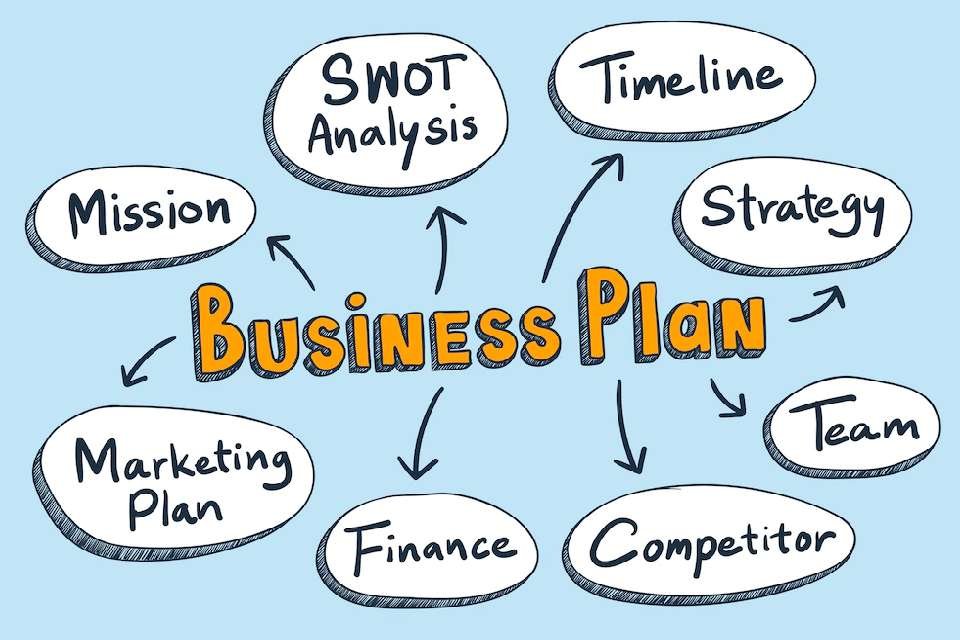Whenever someone in the fields of business talks about strategies, then you might have definitely heard of what is business strategy. The progress of any not entirely set in stone by the viability of the methodology it follows. A procedure makes sense of how an organization intends to contend in a market and how it means to develop at a benefit.
There are numerous instances of effective organizations internationally, especially the one’s that follows good business ethics. While a strong group and funds have been significant elements in their prosperity, there is another viewpoint which guarantees that organizations accomplish what they have decided to do – an idiot proof business technique.
Besides, as each business has it’s own business activities, unmistakable objectives, they embrace various techniques to accomplish them. The business system separates fruitful organizations from the “have-beens”.
Organizations overall sell labor and products in cutthroat business sectors that expect them to expand the incentive for proprietors and investors to get their future presence.
This requires an arrangement that assists supervisors with directing their choices and use assets successfully to accomplish key targets by executing the key business activities of entrepreneur. This plan is otherwise called a business system.
Contents
- 1 What is business strategy?
- 2 How to build a business strategy?
- 3 6 elements to build a business strategy
- 4 Importance of building a business strategy
- 5 Key aspects of business strategy
- 6 Business strategy vs business plan vs business model
- 7 Levels of business strategies
- 8 Nature of business strategy
- 9 What are the key components of a business strategy?
- 10 How do you formulate a business strategy?
- 11 Types of business strategies
- 12 How to measure success of business strategy?
- 13 When to focus on business strategy?
- 14 Business strategy examples – companies
- 15 Business strategy examples
- 16 Conclusion
What is business strategy?
A business strategy is that part of growth business strategies which outlines the plan of action to achieve the vision, mission, and set goals of an organization and guides the decision-making processes to improve the company’s financial stability in a competing market.

What is business strategy?
A business strategy outlines the plan of action to achieve the vision and set objectives of an organization and guides the decision-making processes to improve the company’s financial stability in a competing market.
Despite the fact that it is not difficult to characterize, framing and executing it separates a business. A business strategy alludes to every one of the choices taken, and activities embraced by a business for accomplishing the bigger vision.
Understanding what business technique is and how to execute it appropriately can assist organizations with becoming business sector pioneers in their area. Definitively, a business system is the foundation of each and every business, and any deficiencies could imply that the business objectives get lost halfway.
A business strategy is the mix of the multitude of choices made and moves performed by the business to achieve business objectives and to get a serious situation on the lookout.
It is the foundation of the business as it is the guide which prompts the ideal objectives. Any shortcoming in this guide can bring about the business losing all sense of direction in the horde of overpowering contenders.
Business strategy definition
Business strategy is crucial for any organization trying to develop its business in an essential way, yet what precisely is a business technique?

Set forth plainly, business strategy is a reasonable arrangement of plans, activities and objectives that frames how a business will contend in a specific market, or markets, with an item or number of items or administrations.
Yet, while easy to figure out in principle, fostering a decent business strategy – and afterward really carrying out it – is no simple errand.
Business strategy can be perceived as the game-plan or set of choices which help the business people in accomplishing explicit business targets.
It is only an end-all strategy that the administration of an organization executes to get a serious situation on the lookout, continue its tasks, satisfy clients and accomplish the ideal finishes of the business.
In business, it is the long-range sketch of the ideal picture, course and objective of the association. It is a plan of corporate aim and activity, which is painstakingly arranged and deftly planned with the motivation behind:
- Achieving effectiveness,
- Perceiving and utilizing opportunities,
- Mobilizing resources,
- Securing an advantageous position,
- Meeting challenges and threats,
- Directing efforts and behavior and
- Gaining command over the situation.
A business strategy is a bunch of cutthroat moves and activities that a business uses to draw in clients, contend effectively, fortifying execution, and accomplish hierarchical objectives. It frames how business ought to be done to arrive at the ideal finishes.
Business methodology outfits the top administration with an incorporated system, to find, dissect and take advantage of helpful open doors, to detect and meet expected dangers, to utilize assets and qualities, to offset shortcoming.
How to build a business strategy?
A business technique should consider various elements including the market, contenders, and the business climate, as well as the organization’s construction, assets and shortcomings. It ought to likewise be adequately adaptable to deal with change.

Arranging and setting up a business procedure hence requires solid abilities in essential preparation and business examination, as well as a decent comprehension of capabilities like showcasing, deals, and circulation.
Business system includes covering off the rudiments, as recorded above, yet what is expected to figure out a fruitful business procedure? The present world is in nonstop change.
Business isn’t a similar today as it was yesterday – or what it will be tomorrow. So any business procedure should be:
- Flexible
- Adaptable
- Anchored in up-to-date research
6 elements to build a business strategy
Building or planning for any good business strategy involves a number of key elements and we have listed the most common and popular ones here:

1. Leadership vision:
A business system ought to come from the pioneers. Having a reasonable initiative vision is a vital beginning stage. Where are we going and why?
2. Culture:
Organization culture is a critical driver to executing an effective business methodology. Without a steady culture, you will not accomplish anything.
3. Strategic marketing plan:
Obviously a showcasing idea or promoting ideas are just fine, yet without a reasonable advertising plan no business technique can work. Learn how a business in marketing can help to achieve this.
4. Management:
A solid and moving supervisory group is important to carry out your business system.
5. Systems:
You additionally need powerful and proficient business frameworks behind you in the event that you are to carry out your business system effectively.
6. Resources:
And you’ll require a lot of assets.
Importance of building a business strategy
When you initiate a business, the significance of business system can’t be disregarded. Any pioneer who knows nothing about the significance can’t guarantee the drawn out manageability of their association.

As the business climate, today is turning out to be progressively serious, the significance of business system can’t be underplayed. We’ve assembled a few justifications for why concocting ought to be your main goal.
- In the underlying period of a business, a great deal of arranging is required. While an arrangement explains the objectives, the methodology helps in executing and arriving at the vision.
- At the point when pioneers figure out a technique, it assists them with grasping their assets and shortcomings. Along these lines, they can gain by what they are great at and develop their more vulnerable viewpoints.
- It guarantees that each part of a business is arranged. This implies more productivity and better and more powerful plans. Everybody in the group knows about what they need to do, and the capital is apportioned appropriately.
- It can assist organizations with acquiring an upper hand over others in the fragment. It additionally makes them one of a kind according to their clients.
- It guarantees that pioneers have command over the cycles. This implies they will likewise go as expected.
The presence of a procedure is a basic achievement factor for any business.
Basically, it mirrors the qualities and shortcomings of the organization and answers how the organization intends to answer the dangers and amazing open doors in the market in which it works.
A procedure considers the assets within reach and how to best convey them to accomplish its set targets.
That is the reason a procedure is much of the time called the beacon for an organization’s administration: It adjusts the endeavors of every single utilitarian division and gives representatives a Northstar guides their day to day navigation.
To make this point even more clear, suppose a business wouldn’t have a system on how it will contend in a market:
The shortfall of such an outline would prompt scattered activities in every division, restricting the association’s viability all in all. This confusion generally brings about a deficiency of cutthroat power that will be taken advantage of on the lookout.
A business objective without a procedure is only a fantasy. It is something like a bet on the off chance that you go into the market without a very much arranged technique.
With the expansion in the opposition, the significance of business system is becoming obvious and there’s an enormous expansion in the kinds of business procedures utilized by the organizations. The following are five justifications for why a procedure is essential for your business.
1. Planning:
Business procedure is a piece of a field-tested strategy. While the marketable strategy defines the objectives and targets, the methodology gives you a method for satisfying those objectives. It is an arrangement to reach where you plan to.
2. Strengths and Weaknesses:
The majority of the times, you get to be familiar with your genuine assets and shortcomings while forming a procedure. In addition, it likewise assists you with gaining by what you’re great at and utilize that to eclipse your shortcomings (or dispose of them).
3. Efficiency and Effectiveness:
When each step is arranged, each asset is distributed, and everybody realizes what can anyone do, business exercises become more proficient and viable consequently.
4. Competitive Advantage:
A business procedure centers around exploiting the qualities of the business and involving it as an upper hand to situate the brand in an exceptional manner. This gives a personality to business and makes it one of a kind according to the client.
5. Control:
It likewise chooses the way to be followed and break objectives to be accomplished. This makes it simple to control the exercises and check whether they are going as expected.
Key aspects of business strategy
A business technique is a response to what, how, why, where, and how. This is where sweeping administration courses come into the image. These courses assist pioneers with figuring out the critical perspectives and other quick and dirty of a business methodology. You can seek after these administration courses to refresh yourself on late improvements in this area.

- The primary part is – the mission, vision, and targets. This will have clear directions on what can anyone do when it is to be finished, and the way things are to be finished.
- The subsequent part is – the guiding principle of a business, which ought to be clear right at the start.
- The third part is – a SWOT examination. SWOT alludes to qualities, shortcomings, potential open doors, and dangers. This will give a thought of the business’ ongoing standing.
- The fourth part is – functional strategies which allude to how the organization will accomplish the characterized goals proficiently and actually.
- The fifth part is – asset obtainment and designation. It will give replies about the number of assets that are required, how might they be appropriated, and so forth.
- The 6th part is – estimation, which alludes to how each movement of the business will be stayed focused and estimated against achievements that have been set.
Business strategy vs business plan vs business model
Allow us now to grasp the contrast between the over three. Business strategy is important for a marketable strategy. Business strategy is a part of a business plan. What’s more, both of these are hence essential for a plan of action or a business model.

A business model is fundamentally a diagram which shows how an organization works, procures income, and accomplishes the ideal results. As a piece of the business plan, a strategy or a business plan characterizes these, and it sets the guide on the most proficient method to accomplish every one of the objectives.
The business strategy is an integral part of the business plan which is in-turn a part of the big conceptual structure which is called as the business model.
The business model is a conceptual structure that explains how a business or a company conducts its operations, makes money, makes profits, generates revenue to its business, and how it intends to achieve its goals and milestones. The business plan defines those goals, milestones, and business strategies outline the roadmap of how to achieve them.
Levels of business strategies
There are three levels at which strategies are typically used: The corporate, business and functional level.
The business objective is accomplished by the compelling execution of various business techniques. While each worker, accomplice, and partner of the organization center around satisfying a solitary business objective, their exercises are characterized by different business procedures as per their level in the association.

Every one of the three levels structure the essential system of an association:
1. Corporate Level:
Corporate level methodologies are the masterful plans of an association’s top administration. They structure the mission and vision explanation and on a very basic level affect the company’s drawn out exhibition. They guide choices around development, acquisitions, broadening and speculations.
Corporate level strategy is a long-range, activity situated, incorporated and complete arrangement planned by the top administration. It is utilized to find out business lines, development and development, takeovers and consolidations, enhancement, mix, new regions for venture and divestment, etc.
The corporate level is the most noteworthy and generally wide level of the business system. It is the marketable strategy which sets the rules of what is to be accomplished and the way that the business is supposed to accomplish it. It sets the mission, vision, and corporate targets for everybody.
2. Business Level:
Business level methodologies coordinate into the corporate vision, however with an emphasis on a particular business. At this level, the vision and goals are transformed into substantial procedures that illuminate how a business will contend on the lookout.
The strategies that connect with a specific business are known as business-level procedures. It is created by the head supervisors, who convert mission and vision into substantial procedures. It resembles a plan of the whole business.
The business unit level is a unit explicit procedure which varies for various units of the business. A unit can be various items or channels which have entirely unexpected tasks. These units structure systems to separate themselves from the contenders utilizing cutthroat procedures and to adjust their goals to the general business objective characterized in the corporate level methodology.
3. Functional Level:
Functional level methodologies are intended to answer how utilitarian divisions like Advertising, HR or Research and development can uphold the characterized business and corporate techniques of an association.
It’s normal for a firm to have numerous techniques at each level. As a matter of fact, this is fundamental to guarantee that the various requirements of each layer are precisely reflected.
Albeit various methodologies convey the gamble of clashing needs and goals, these dangers can be decreased whenever oversaw accurately. We will return to this point in a moment.
Created by the first-line administrators or managers, practical level methodology includes decision making at the functional level concerning specific useful regions like advertising, creation, human asset, innovative work, finance, etc.
In business, there is consistently a requirement for different procedures at different levels as a solitary system isn’t just deficient yet ill-advised as well. Hence, a commonplace business structure generally has three levels.
The functional level techniques are set by various branches of the units. The divisions incorporate yet are not restricted to advertising, deals, tasks, finance, CRM and so forth. These utilitarian level techniques are restricted to everyday activities and choices expected to convey unit level and corporate level procedures, keeping up with connections between various divisions, and satisfying useful objectives.
Nature of business strategy
A business strategy is a blend of proactive activities with respect to the board, to upgrade the organization’s market position and in general execution and responses to surprising turns of events and new economic situations.
The most extreme piece of the organization’s current methodology is a consequence of previously started activities and business draws near, yet when economic situations veer off in an unexpected direction, the organization requires an essential response to adapt to possibilities. Subsequently, for unexpected turn of events, a piece of the business system is formed as a contemplated reaction.
What are the key components of a business strategy?
While a goal is characterized obviously in the marketable strategy, the technique answers all the what’s, why’s, who’s, where’s, when’s, and how’s of the satisfying that goal. Here are the critical parts of a business methodology.

1. Mission, Vision, and Business Goals:
The primary focal point of a business methodology is to satisfy the business objective. It provides the vision and guidance to the business with clear directions of what should be finished, how it should be finished, and who all are answerable for it.
2. Core Values:
It likewise expresses the ‘musts’ and ‘must nots’ of the business which explain a large portion of the questions and provide a reasonable guidance to the high level, units, as well as the divisions.
3. SWOT:
A SWOT (qualities, shortcomings, open doors, and dangers) examination is a once-over of the organization’s ongoing circumstance. It is a vital part of a business procedure as it addresses the ongoing qualities and open doors which the organization can utilize and the shortcomings and dangers which the organization ought to be careful about.
4. Operational Strategies:
Unit and utilitarian business techniques get profound into the functional subtleties of how the work should be finished to be best and effective. This saves a ton of time and exertion as everybody understands what should be finished.
5. Resource Procurement & Allocation Plan:
The methodology additionally answers where and how might you obtain the expected assets, how might it be distributed, and who will be liable for taking care of it.
6. Measurement:
Except if there are no control gauges, the feasibility of a business procedure can’t be surveyed as expected. A decent business technique generally incorporates ways of following the organization’s result and execution against the set targets.
How do you formulate a business strategy?
A business strategy frames the game plan to accomplish the vision and set goals of an association and guides the dynamic cycles to work on the organization’s monetary dependability in a contending market.
The above definition as of now offers some functional guidance on the most proficient method to construct a successful technique:

A system needs to frame the vision of a business, characterize its objectives and the way things will develop and contend long haul.
The strategy building cycle can be separated into five stages:
1. Define your vision
2. Set your top-level objectives
3. Analyze your business and the market
4. Define how to gain competitive advantage
5. Build a strategy framework

Step 1: Define you vision
Most web-based sources propose that technique detailing ought to start by characterizing the targets of an association. However, this arrives at excessively far excessively quick, as it assumes that the contribution, the market and the objective clients have proactively been characterized.

For a procedure to find true success, it should initially consider the organization’s guiding principle and its ideal future situation on the lookout. This is otherwise called the organization’s vision.
Instances of vision statements from probably the biggest organizations include:
“Apple strives to bring the best personal computing experience to students, educators, creative professionals, and consumers around the world through its innovative hardware, software, and internet offerings.” – Apple.
“To be earth’s most customer-centric company; to build a place where people can come to find and discover anything they might want to buy online.” – Amazon.
In view of a company’s vision, the proposition, its clients and the market can be characterized.
This is a significant stage in the methodology building process since it guarantees that the planned system mirrors the genuine requirements of the applicable market.
a) Offer and Value Proposition:
A compelling business system assembles straightforwardly on the organization’s contribution and offer.
The previous spreads out what labor and products are offered, while the offer makes sense of why individuals ought to get them in any case.
Note that the incentive responses why a firm exists and how it is unique in relation to its opponents. At the end of the day, it clears up how a firm designs for drive interest and contend on the lookout.
To outline this with a model, investigate Shopify. Their incentive is to offer a solitary online business stage that allows its clients to sell across numerous channels.
b) Customers:
One more fundamental stage in building a compelling business system is to characterize the kind of client an organization serves.
Clients are either sorted as purchasers (B2C) or organizations (B2B).
The two gatherings have various rules, reasons and inspirations for buying labor and products. Realizing them permits a firm to address their particular requirements and needs in its procedure precisely.
c) Target Market:
At last, technique manufacturers should be clear about the market their contribution and offer are focusing on.
If a firm offers to purchasers (B2C), a market can be characterized by segment and financial variables, like orientation, age, occupation, schooling, pay, riches and where somebody resides.
On the off chance that, notwithstanding, the contribution targets different organizations (B2B), markets are regularly characterized by utilizing variables, for example, the business, business or deals model of the designated client gatherings.
I suggest perusing this article from Annmarie Hanlon if you have any desire to more deeply study the particulars of portioning a market.
Step 2: Set your top-level objectives
In the wake of characterizing the vision, the subsequent stage in figuring out a business system is to set an association’s high level targets.
These targets are typically centered around expanding a company’s deals and benefits, as they guarantee its presence and further develop the investor esteem if public.

Strategic objectives are reason articulations that assist with making a general vision and put forth objectives and quantifiable strides for an association to assist with accomplishing the ideal result. An essential goal is best when it is quantifiable either by factual outcomes or detectable information.
That is the reason a methodology basically means to respond to the subject of how a business can contend in the market to develop its income, while likewise advancing its monetary position.
Note that the definition of significant level targets incorporates no objectives to accomplish an organization’s central goal or to mirror its fundamental beliefs.
This is on the grounds that the sole reason for a conventional business technique is to expand the organization’s financial incentive for its proprietors or investors.
The basic beliefs and mission are subsequently considered while planning the lower-level techniques, like the promoting or functional procedure.
Step 3: Analyze your business and the market
When the vision and targets are characterized, system developers need to become mindful of their business’ assets and shortcomings and the potential open doors and difficulties in the commercial center.

Market analysis is one of the detailed evaluation of your business’ objective market and cutthroat scene inside a particular industry. This investigation allows you to project the achievement you can expect when you present your image and its items to customers inside the market.
This should be possible utilizing a SWOT analysis (Strengths, Weaknesses, Opportunities, Threats):
The data got over a SWOT examination fills in as a reason for the procedure plan that considers the organization’s inward qualities and the outer circumstance of the market portion.
These bits of knowledge permit leaders to guarantee that a company’s assets exploit the open doors on the lookout, while likewise tending to possible shortcomings and dangers that can restrict the association’s drawn out progress.
Step 4: Define how to gain competitive advantage
Competitive advantage alludes to the manners in which that an organization can create merchandise or convey benefits better compared to its rivals. It permits an organization to accomplish prevalent edges and produce an incentive for the organization and its investors.
An Competitive advantage is something that won’t be quickly duplicated and is restrictive to an organization or business. This worth is made inside and separates the business from its opposition.

6 ways to gain competitive advantage:
1. Create a corporate culture that attracts the best talent
2. Define niches that are under-serviced
3. Understand the DNA footprint of your ideal customer
4. Clarify your strengths
5. Establish your unique value proposition
6. Reward behaviors that support corporate mission and value
The fourth move toward the procedure plan addresses the topic of how the set goals are accomplished.
Firms that sell in aggressive businesses need to characterize how they need to contend on the lookout, spur interest and increment their deals and edges.
Step 5: Build a strategy framework
As a business specialist, and strategist, expert, supervisor, chief, or pioneer, you are generally watching out for ways of working on your association’s presentation. One method for accomplishing that is by making and executing a significant business procedure.
A big part of the achievement factors for any specialty unit rely on the exceptional key system they follow. Vital structures are the foundation of your business, It can either make it or break it.

Strategy frameworks are instruments that assist with organizing business thinking and guide organizations as they develop and achieve their missions. They can likewise be utilized to investigate business issues and foster methodologies. What’s more, system experts frequently use them to convey their answers for their clients.
Strategy frameworks are various. There is one for any situation and quite possibly choosing one may really overpower another person to the field.
In light of the execution of the past advances, a nonexclusive business methodology can be planned.
Be that as it may, works, for example, promoting or money won’t contribute actually to this conventional methodology except if it is converted into more unambiguous lower-level systems.
The development of these lower-level methodologies that sit under a conventional business methodology is known as a system structure.
It guarantees the outcome of the conventional strategy, as it catches the vision and necessities of the single divisions and adjusts them to the more significant level goals.
Item, marking, promoting or functional procedures are a couple of models that add to the outcome of a company’s general nonexclusive business technique.
Note that essential systems can immediately turn out to be very perplexing by and by. That is the reason administrators need to guarantee that they consistently audit the arrangement among low-and undeniable level procedures.
Types of business strategies
Harvard Business School professor Michael E. Porter identified three types of generic strategies that businesses can choose from when defining their competitive advantage:
1. Cost Leadership,
2. Differentiation, or
3. Focus.
Notwithstanding, firms can likewise neglect to actually seek after one of these conventional methodologies. Doorman alludes to this as being “trapped in the center”.
For this situation, an organization doesn’t offer an item or administration sufficiently interesting to tempt clients to purchase. Simultaneously, the cost of the contribution is excessively high to contend actually on the lookout.
Inability to acquire an upper hand will bring about an unfortunate deals execution, which undermines the future organization’s presence.
We should investigate the various ways an organization can acquire an upper hand:
1. Cost Leadership
Cost leadership or cost initiative alludes to an organization’s capacity to deliver an item at the most reduced cost in its industry.
This cost benefit can be accomplished by utilizing economies of scale, exclusive advancements or the capacity to make and keep up with money saving advantages along the store network.
The expense initiative methodology requires a firm to really bring down its expense structures while charging costs for items are in accordance with the business normal.
For Example, Low passage carrier Ryanair is a normal illustration of a firm that applies an expense initiative technique. They effectively contend in the aircraft business by driving down costs and use economies of scale. Hence, Ryanair just works one sort of airplane (Boeing 737-200) in its whole armada.
2. Differentiation
In a differentiation strategy, a firm tries to make a remarkable proposition that is esteemed by its objective clients. Purchasers should see the proposal as undeniably more important contrasted with different options in the business. Consequently, an organization can request greater costs for its items.
For example, Starbucks is an incredible illustration of a firm that has effectively executed a separation methodology. While it sells espresso as a broadly accessible ware, its very much planned stores, and the unparalleled number of flavor varieties are the justification for why clients will pay a premium.
3. Focus
The conventional procedure of center focuses on just few objective market fragments. Doorman’s framework characterizes the serious extension in these cases as thin, as a firm just focuses on a little part of the more extensive market section.
All things considered, an organization can either have an expense center or a separation center:
At the point when a firm looks to acquire an expense advantage, it follows an expense centered procedure. The company’s proposition is a minimal expense option in contrast to the main item in the market that actually requests to a particular gathering of purchasers.
Then again, the separation center looks to take care of a particular need in a client section. This separation center is the exemplary specialty advertising technique numerous little and nearby organizations follow to contend with the bigger chains in their market.
For example, Little web-based shops that work in offering veggie lover and vegan items are a genuine illustration of firms that follow a nonexclusive center procedure. Their restricted objective extension permits them to turn into the favored decision of ecological and wellbeing cognizant client portions.
How to measure success of business strategy?
Business strategies are fruitful when they are straightforwardly answerable for development and worked on serious or monetary execution.
The outcome of a well thought out course of action can be assessed by checking a scope of Key Performance Indicators (KPI’s).
Nonetheless, it is vital that,
- These KPIs measure the degree of accomplishment of the targets characterized in sync two of the procedure definition process.
- The KPIs are characterized before the procedure execution happens to guarantee exact estimation.
Typically, some or the accompanying KPIs are all deliberate while executing another business methodology:
Examples of Growth KPIs:
- Sales revenue
- Number of customers
- Repeat customer sales
- Customer retention rate
- Conversion Rate
- Average Order Value (AOV)
- Business Volume
Examples of Competitive Position KPIs:
- Market share
- Market position
- Sales win rate
- Brand awareness & press mentions
- Margin position vs. industry average
- Sales growth vs. industry average
Examples of Financial Performance KPIs:
- Gross Profit
- Net Profit
- Operating Profit
- EBIT and EBITDA
- Return on Assets
- Free Cash Flow
- Operating Cash Flow
In practice, the organizations might quantify procedure outcome in a more granular manner. This is on the grounds that singular divisions characterize their own lower-level methodologies.
When to focus on business strategy?
It is dependably gainful to carry out a business system since it carries more deliberate idea to your tasks. At the point when organizations make sizable movements, business methodologies become much more significant in light of the fact that they lay the foundation on the best way to boost returns. However, a procedure isn’t just about development; it likewise guarantees you make the most of an accessible open door on the lookout.
The following are a couple of circumstances when you might expect to zero in on business system:
- Starting a new business
- Plans to sell an existing enterprise
- Raising funds among family, friends, the public or investors
- Seeking a new business partner
- Re-branding an existing business
- Investing money into improving a business
- Expanding an organization into a new market or region
- Merging with another organization
- Major internal changes such as personnel changes
Business strategy examples – companies
To represent the previous talked about standards, I have assembled two instances of organizations that have effectively executed their nonexclusive business methodology: Amazon and Reckitt Benckiser.
Example 1: Amazon
Amazon is known for its incredible client care and quick delivery choices.
And keeping in mind that its vision is to be earth’s most client driven organization, Amazon makes this a reality by persistently improving in existing and new business sectors. The outcome? Further development and more noteworthy investor esteem.
In his most memorable investor letter from 1997, Jeff Bezos himself illustrated the four rules that guide the organization: client fixation as opposed to contender center, energy for creation, obligation to functional greatness and long haul thinking.
Amazon’s conventional business technique is to acquire an upper hand by driving down costs (cost initiative), matched with its capacity to improve in cutthroat business sectors.
The center is generally something very similar: serving the necessities of end-clients.
This permits Amazon to overwhelm rivalry frequently battles to find the tech monster in somewhere around quite a while (ST-System).
Its lower-level techniques (functional, showcasing, and so on) all follow the nonexclusive procedure of zeroing in on decision, cost and economies of scale to make an incentive for clients.
This essential structure has permitted Amazon to become one of the best tech organizations in the 21st hundred years.
Example 2: Reckitt Benckiser
Albeit the organization’s name isn’t known by numerous shoppers, Reckitt’s image portfolio comprises of significant family brands, like Completion, Dettol, Nurofen, Evaporate, or Durex.
Confronted with easing back deals and expanded rivalry back in 2012, the organization needed to change its business methodology to get back to a way of strong business development.
Under the new methodology, RB:
- Zeroed in on Research and development for new product offerings that permitted it to accomplish its undeniable level targets to expand deals and edges;
- Expanded financial plans in business sectors developed better than expected to animate further development;
- Redesigned its image and promoting systems and expanded spending plans in those areas;
- Set and firmly observed numerous key execution markers with the mean to expand its net income development by +200bps versus market normal every year until 2017.
- While Reckitt couldn’t accomplish its set focuses on, the alterations of everything business procedure assisted the organization with developing its deals and benefits over the market normal.
Accordingly, RB developed £33bn in incentive for its investors somewhere in the range of 2012 and 2017.
Business strategy examples
A business strategy can feature qualities for you to utilize as an exceptional selling point for your item and administration. The following are six instances of extraordinary business systems:
1. Product differentiation:
Many organizations, especially in the innovation or auto space, separate themselves through their advancement. To get yourself seen utilizing this business system, you expect to feature that your items are unrivaled due to their innovation, valuing, elements or even plan. Item separation is a successful procedure since it separates you from contenders. Consequently, clients are faithful to you as a result of the uniqueness no one but you can offer them.
2. Improve customer experience:
Organizations construct their standing on praiseworthy client assistance. As a rule, organizations might battle in a specific region as far as they can tell, so a business technique zeroed in on further developing help would for the most part focus its goals on something like web-based help or a more viable call place.
3. Cornering a younger market:
Associations see extraordinary worth in taking advantage of clients early on so they keep partner with a brand as they progress in years. A few bigger organizations purchase out their rivals to acquire a portion of this rewarding business sector. Cornering a youthful market permits you to build your presence in another segment while holding your current client base.
4. Attractive pricing strategy:
The manner in which you value your items and administrations can affect the manner in which clients see your business. A reasonable valuing methodology is an incredible choice to draw in new clients. Evaluating your items past what normal clients can bear the cost of gives an optimistic worth to your image.
Both estimating procedures are strong, however they require an alternate business approach. Organizations that keep their costs low expect to accomplish higher volumes to be productive. In examination, organizations who pick more exorbitant costs can keep up with the eliteness of their item while holding a huge overall revenue for each item.
5. Sustainability:
As individuals become all the more naturally cognizant, the interest for practical items has expanded too. A business procedure that positions an association as a socially capable business likewise exhibits other helpful qualities, like trust and uprightness. A few instances of reasonable strategic policies incorporate objectives to lessen energy costs or to diminish the organization’s carbon impression by executing a reusing program.
6. Cross-sell more products:
A few associations center around offering more items to a similar client. This methodology is famous among banks, protection firms and online retailers. By expanding the quantity of items sold per client, you can diminish your client procurement cost and save on advertising.
Conclusion
Understanding what is business strategy is simple but when it comes to implementing it, it takes lots of thoughts into building one. The best part is that there are plenty of business strategy examples, which we have listed above will help you understand better and implement it better.
For the final thoughts, a business strategy is that part of growth business strategies which outlines the plan of action to achieve the vision, mission, and set goals of an organization and guides the decision-making processes to improve the company’s financial stability in a competing market.



2 thoughts on “What is business strategy and how to build one? – business strategy definition and examples”